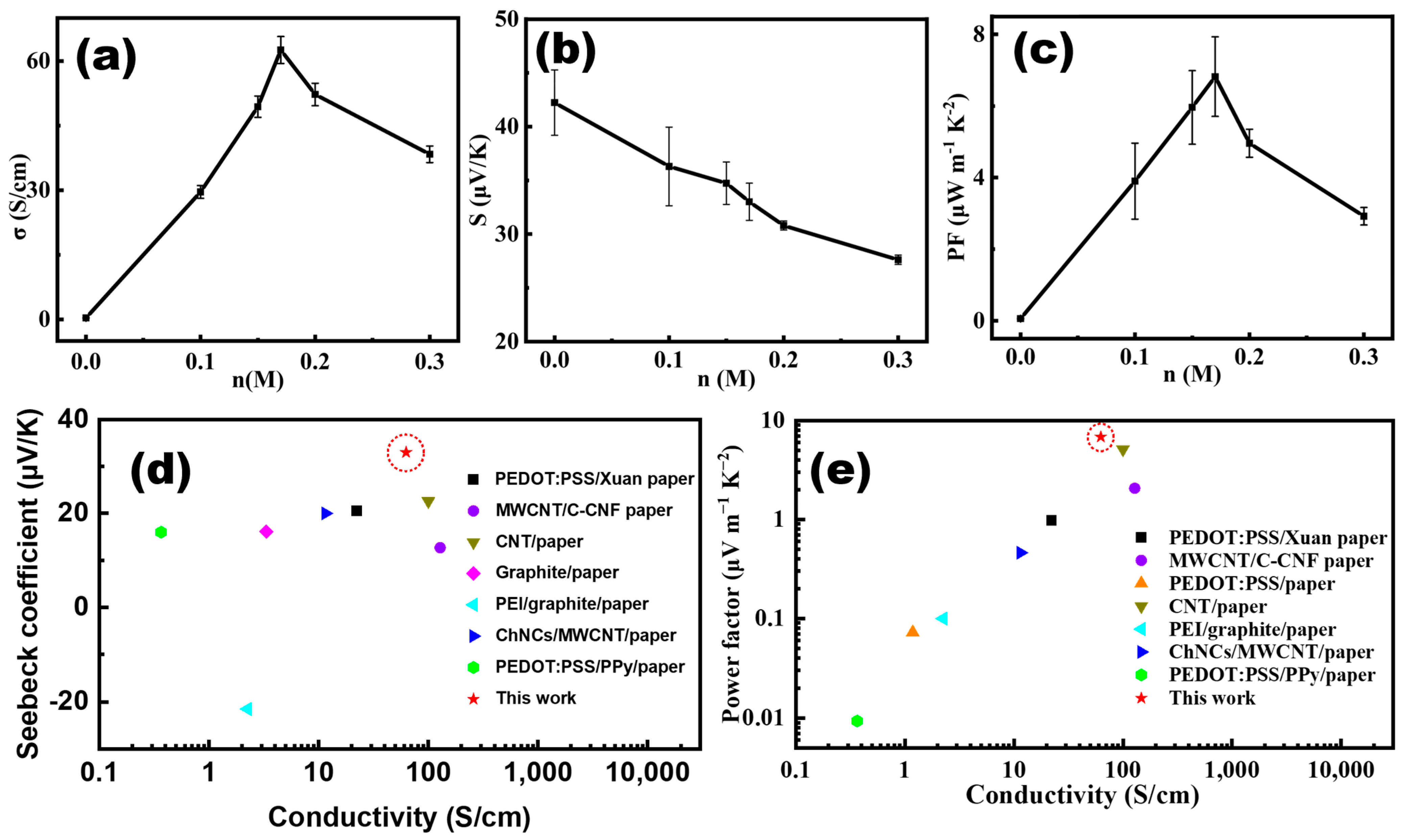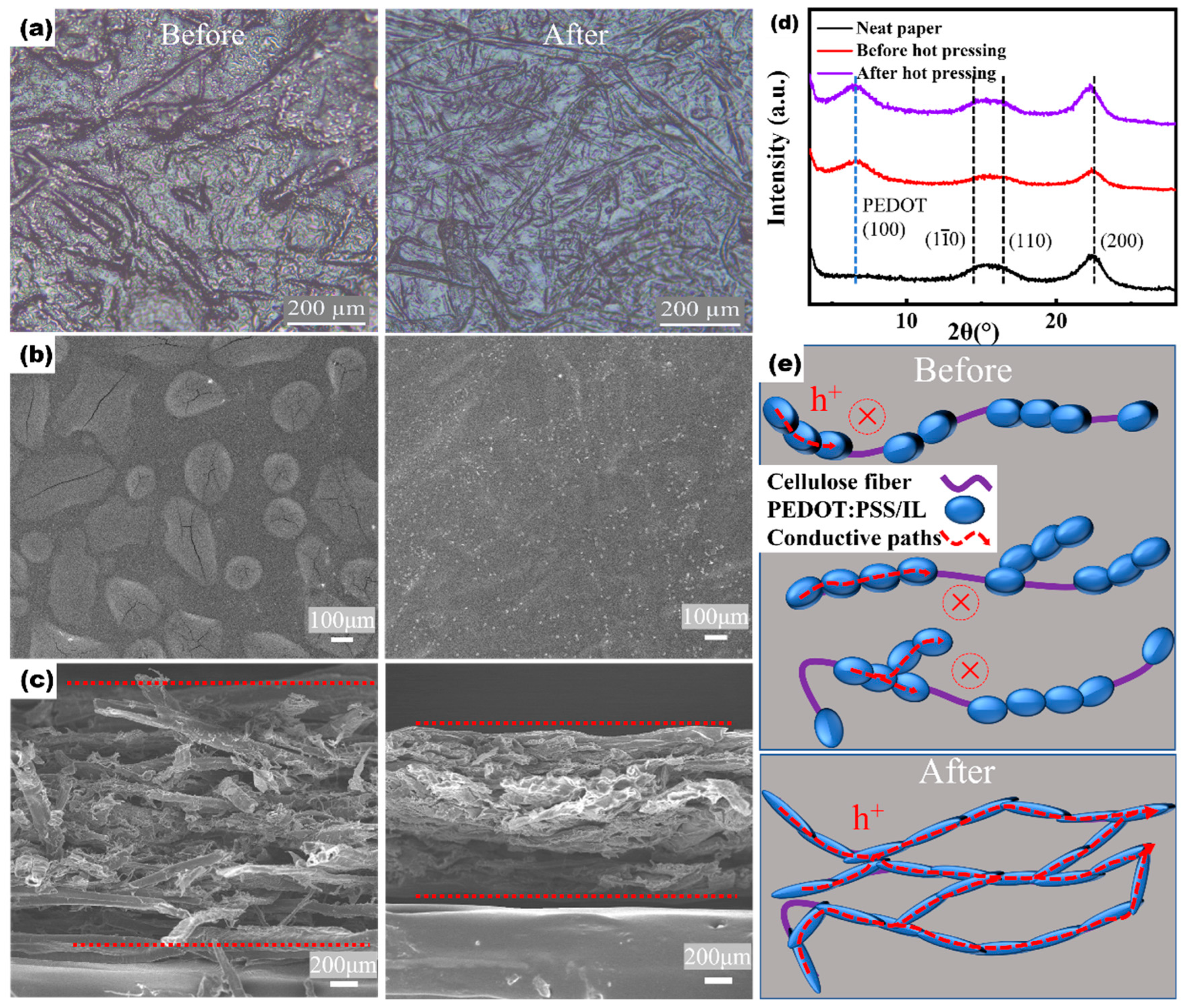Highly Flexible and Foldable Paper-Based Thermoelectric Generator Prepared with Post-Treatment-Free PEDOT:PSS Hybrid Ink
Abstract
:1. Introduction
2. Experimental Section
2.1. Materials
2.2. Sample Preparation
2.3. Sample Characterization
3. Results and Discussion
4. Conclusions
Supplementary Materials
Author Contributions
Funding
Institutional Review Board Statement
Data Availability Statement
Acknowledgments
Conflicts of Interest
References
- Ren, W.; Sun, Y.; Zhao, D.; Aili, A.; Zhang, S.; Shi, C.; Zhang, J.; Geng, H.; Zhang, J.; Zhang, L.; et al. High-performance wearable thermoelectric generator with self-healing, recycling, and Lego-like reconfiguring capabilities. Sci. Adv. 2021, 7, eabe0586. [Google Scholar] [CrossRef]
- Pazhamalai, P.; Krishnamoorthy, K.; Manoharan, S.; Mariappan, V.K.; Kim, S.-J. Monolithic integration of MoS2 quantum sheets on solid electrolyte for self-charging supercapacitor power cell governed by piezo-ionic effect. Sustain. Mater. Technol. 2022, 33, e00459. [Google Scholar] [CrossRef]
- He, T.; Wang, H.; Lu, B.; Guang, T.; Yang, C.; Huang, Y.; Cheng, H.; Qu, L. Fully printed planar moisture-enabled electric generator arrays for scalable function integration. Joule 2023, 7, 935–951. [Google Scholar] [CrossRef]
- Li, X.; He, Z.; Liu, Z.; Chen, Y.; Zhou, Z.; Chen, G.; Qi, W.; Rauber, D.; Kay, C.W.M.; Zhang, P. High-performance post-treatment-free PEDOT based thermoelectric with the establishment of long-range ordered conductive paths. Chem. Eng. J. 2023, 454, 140047. [Google Scholar] [CrossRef]
- Cao, T.; Shi, X.-L.; Chen, Z.-G. Advances in the design and assembly of flexible thermoelectric device. Prog. Mater. Sci. 2023, 131, 101003. [Google Scholar] [CrossRef]
- Li, X.; Zou, R.; Liu, Z.; Mata, J.; Storer, B.; Chen, Y.; Qi, W.; Zhou, Z.; Zhang, P. Deciphering the superior thermoelectric property of post-treatment-free PEDOT:PSS/IL hybrid by X-ray and neutron scattering characterization. NPJ Flex. Electron. 2022, 6, 6. [Google Scholar] [CrossRef]
- Xu, S.; Shi, X.-L.; Dargusch, M.; Di, C.; Zou, J.; Chen, Z.-G. Conducting polymer-based flexible thermoelectric materials and devices: From mechanisms to applications. Prog. Mater. Sci. 2021, 121, 100840. [Google Scholar] [CrossRef]
- Su, Z.; Yang, Y.; Huang, Q.; Chen, R.; Ge, W.; Fang, Z.; Huang, F.; Wang, X. Designed biomass materials for “green” electronics: A review of materials, fabrications, devices, and perspectives. Prog. Mater. Sci. 2022, 125, 100917. [Google Scholar] [CrossRef]
- Meng, Q.; Song, H.; Du, Y.; Ding, Y.; Cai, K. Facile preparation of poly(3,4-ethylenedioxythiophene): Poly(styrenesulfonate)/Ag2Te nanorod composite films for flexible thermoelectric generator. J. Mater. 2021, 7, 302–309. [Google Scholar] [CrossRef]
- Burton, M.; Howells, G.; Atoyo, J.; Carnie, M. Printed Thermoelectrics. Adv. Mater. 2022, 34, 2108183. [Google Scholar] [CrossRef]
- Zhang, Y.; Zhang, L.; Cui, K.; Ge, S.; Cheng, X.; Yan, M.; Yu, J.; Liu, H. Flexible Electronics Based on Micro/Nanostructured Paper. Adv. Mater. 2018, 30, 1801588. [Google Scholar] [CrossRef]
- Panigrahy, S.; Kandasubramanian, B. Polymeric thermoelectric PEDOT: PSS & composites: Synthesis, progress, and applications. Eur. Polym. J. 2020, 132, 109726. [Google Scholar]
- Lin, Y.; Gritsenko, D.; Liu, Q.; Lu, X.; Xu, J. Recent Advancements in Functionalized Paper-Based Electronics. ACS Appl. Mater. Interfaces 2016, 8, 20501–20515. [Google Scholar] [CrossRef] [PubMed]
- Li, Q.; Zhou, Q.; Wen, L.; Liu, W. Enhanced thermoelectric performances of flexible PEDOT:PSS film by synergistically tuning the ordering structure and oxidation state. J. Mater. 2020, 6, 119–127. [Google Scholar] [CrossRef]
- Xu, Y.; Jia, Y.; Liu, P.; Jiang, Q.; Hu, D.; Ma, Y. Poly(3,4-ethylenedioxythiophene) (PEDOT) as promising thermoelectric materials and devices. Chem. Eng. J. 2021, 404, 126552. [Google Scholar] [CrossRef]
- Petsagkourakis, I.; Kim, N.; Tybrandt, K.; Zozoulenko, I.; Crispin, X. Poly(3,4-ethylenedioxythiophene): Chemical Synthesis, Transport Properties, and Thermoelectric Devices. Adv. Electron. Mater. 2019, 5, 1800918. [Google Scholar] [CrossRef]
- Huang, J.; Liu, X.; Du, Y. Fabrication of free-standing flexible and highly efficient carbon nanotube film/PEDOT: PSS thermoelectric composites. J. Mater. 2022, 8, 1213–1217. [Google Scholar] [CrossRef]
- Kroon, R.; Mengistie, D.A.; Kiefer, D.; Hynynen, J.; Ryan, J.D.; Yu, L.; Müller, C. Thermoelectric plastics: From design to synthesis, processing and structure–property relationships. Chem. Soc. Rev. 2016, 45, 6147–6164. [Google Scholar] [CrossRef]
- Jiang, Q.; Liu, C.; Xu, J.; Lu, B.; Song, H.; Shi, H.; Yao, Y.; Zhang, L. Paper: An effective substrate for the enhancement of thermoelectric properties in PEDOT:PSS. J. Polym. Sci. Part B Polym. Phys. 2014, 52, 737–742. [Google Scholar] [CrossRef]
- Wei, Q.; Mukaida, M.; Kirihara, K.; Naitoh, Y.; Ishida, T. Polymer thermoelectric modules screen-printed on paper. RSC Adv. 2014, 4, 28802–28806. [Google Scholar] [CrossRef]
- Deng, L.; Zhang, Y.; Wei, S.; Lv, H.; Chen, G. Highly foldable and flexible films of PEDOT:PSS/Xuan paper composites for thermoelectric applications. J. Mater. Chem. A 2021, 9, 8317–8324. [Google Scholar] [CrossRef]
- GB/T 1040.1-2018; Plastics—Determination of Tensile Properties—Part 1: General Principles. China National Standard Press: Beijing, China, 2018.
- Yao, H.; Fan, Z.; Cheng, H.; Guan, X.; Wang, C.; Sun, K.; Ouyang, J. Recent Development of Thermoelectric Polymers and Composites. Macromol. Rapid Commun. 2018, 39, 1700727. [Google Scholar] [CrossRef] [PubMed]
- Palaporn, D.; Mongkolthanaruk, W.; Faungnawakij, K.; Kurosaki, K.; Pinitsoontorn, S. Flexible Thermoelectric Paper and Its Thermoelectric Generator from Bacterial Cellulose/Ag2Se Nanocomposites. ACS Appl. Energy Mater. 2022, 5, 3489–3501. [Google Scholar] [CrossRef]
- Gao, J.; Miao, L.; Liu, C.; Wang, X.; Peng, Y.; Wei, X.; Zhou, J.; Chen, Y.; Hashimoto, R.; Asaka, T.; et al. A novel glass-fiber-aided cold-press method for fabrication of n-type Ag2Te nanowires thermoelectric film on flexible copy-paper substrate. J. Mater. Chem. A 2017, 5, 24740–24748. [Google Scholar] [CrossRef]
- Liu, Z.; Li, X.; Zou, R.; Zhou, Z.; Ma, Q.; Zhang, P. Deciphering the quaternary structure of PEDOT:PSS aqueous dispersion with small-angle scattering. Polymer 2022, 261, 125415. [Google Scholar] [CrossRef]
- Li, H.; Zong, Y.; Ding, Q.; Han, W.; Li, X. Paper-based thermoelectric generator based on multi-walled carbon nanotube/carboxylated nanocellulose. J. Power Sources 2021, 500, 229992. [Google Scholar] [CrossRef]
- Miyama, A.; Oya, T. Improved performance of thermoelectric power generating paper based on carbon nanotube composite papers. Carbon Trends 2022, 7, 100149. [Google Scholar] [CrossRef]
- He, Y.; Lin, X.; Feng, Y.; Luo, B.; Liu, M. Carbon Nanotube Ink Dispersed by Chitin Nanocrystals for Thermoelectric Converter for Self-Powering Multifunctional Wearable Electronics. Adv. Sci. 2022, 9, 2204675. [Google Scholar] [CrossRef]
- Brus, V.V.; Gluba, M.; Rappich, J.; Lang, F.; Maryanchuk, P.D.; Nickel, N.H. Fine Art of Thermoelectricity. ACS Appl. Mater. Interfaces 2018, 10, 4737–4742. [Google Scholar] [CrossRef]
- Mulla, R.; Jones, D.R.; Dunnill, C.W. Thermoelectric Paper: Graphite Pencil Traces on Paper to Fabricate a Thermoelectric Generator. Adv. Mater. Technol. 2020, 5, 2000227. [Google Scholar] [CrossRef]
- Li, J.; Du, Y.; Jia, R.; Xu, J.; Shen, S.Z. Thermoelectric Properties of Flexible PEDOT:PSS/Polypyrrole/Paper Nanocomposite Films. Materials 2017, 10, 780. [Google Scholar] [CrossRef] [PubMed]
- Tu, S.; Tian, T.; Lena Oechsle, A.; Yin, S.; Jiang, X.; Cao, W.; Li, N.; Scheel, M.A.; Reb, L.K.; Hou, S.; et al. Improvement of the thermoelectric properties of PEDOT:PSS films via DMSO addition and DMSO/salt post-treatment resolved from a fundamental view. Chem. Eng. J. 2022, 429, 132295. [Google Scholar] [CrossRef]
- Gong, J.; Li, J.; Xu, J.; Xiang, Z.; Mo, L. Research on cellulose nanocrystals produced from cellulose sources with various polymorphs. RSC Adv. 2017, 7, 33486–33493. [Google Scholar] [CrossRef]
- French, A.D. Idealized powder diffraction patterns for cellulose polymorphs. Cellulose 2014, 21, 885–896. [Google Scholar] [CrossRef]
- Li, X.; Liu, Z.; Zhou, Z.; Gao, H.; Liang, G.; Rauber, D.; Kay, C.W.M.; Zhang, P. Effects of Cationic Species in Salts on the Electrical Conductivity of Doped PEDOT:PSS Films. ACS Appl. Polym. Mater. 2021, 3, 98–103. [Google Scholar] [CrossRef]
- Kee, S.; Kim, N.; Kim, B.S.; Park, S.; Jang, Y.H.; Lee, S.H.; Kim, J.; Kim, J.; Kwon, S.; Lee, K. Controlling Molecular Ordering in Aqueous Conducting Polymers Using Ionic Liquids. Adv. Mater. 2016, 28, 8625–8631. [Google Scholar] [CrossRef]
- Zhou, Y.; Yao, C.; Lin, X.; Oh, J.; Tian, J.; Yang, W.; He, Y.; Ma, Y.; Yang, K.; Ai, B.; et al. Ion Exchange Induced Efficient N-Type Thermoelectrics in Solid-State. Adv. Funct. Mater. 2023, 33, 2214563. [Google Scholar] [CrossRef]
- Wang, H.; Totaro, M.; Veerapandian, S.; Ilyas, M.; Kong, M.; Jeong, U.; Beccai, L. Folding and Bending Planar Coils for Highly Precise Soft Angle Sensing. Adv. Mater. Technol. 2020, 5, 2000659. [Google Scholar] [CrossRef]
- Zhao, X.; Han, W.; Zhao, C.; Wang, S.; Kong, F.; Ji, X.; Li, Z.; Shen, X. Fabrication of Transparent Paper-Based Flexible Thermoelectric Generator for Wearable Energy Harvester Using Modified Distributor Printing Technology. ACS Appl. Mater. Interfaces 2019, 11, 10301–10309. [Google Scholar] [CrossRef]
- Dong, Z.; Liu, H.; Yang, X.; Fan, J.; Bi, H.; Wang, C.; Zhang, Y.; Luo, C.; Chen, X.; Wu, X. Facile fabrication of paper-based flexible thermoelectric generator. npj Flex. Electron. 2021, 5, 6. [Google Scholar] [CrossRef]
- Zhao, X.; Han, W.; Jiang, Y.; Zhao, C.; Ji, X.; Kong, F.; Xu, W.; Zhang, X. A honeycomb-like paper-based thermoelectric generator based on a Bi2Te3/bacterial cellulose nanofiber coating. Nanoscale 2019, 11, 17725–17735. [Google Scholar] [CrossRef] [PubMed]
- Zhang, X.; Hou, Y.; Yang, Y.; Wang, Z.; Liang, X.; He, Q.; Xu, Y.; Sun, X.; Ma, H.; Liang, J.; et al. Stamp-Like Energy Harvester and Programmable Information Encrypted Display Based on Fully Printable Thermoelectric Devices. Adv. Mater. 2023, 35, 2207723. [Google Scholar] [CrossRef] [PubMed]
- Ballo, A.; Grasso, A.D.; Palumbo, G. A Review of Charge Pump Topologies for the Power Management of IoT Nodes. Electronics 2019, 8, 480. [Google Scholar] [CrossRef]
- Himes, C.; Carlson, E.; Ricchiuti, R.J.; Otis, B.P.; Parviz, B.A. Ultralow Voltage Nanoelectronics Powered Directly, and Solely, From a Tree. IEEE Trans. Nanotechnol. 2010, 9, 2–5. [Google Scholar] [CrossRef]





Disclaimer/Publisher’s Note: The statements, opinions and data contained in all publications are solely those of the individual author(s) and contributor(s) and not of MDPI and/or the editor(s). MDPI and/or the editor(s) disclaim responsibility for any injury to people or property resulting from any ideas, methods, instructions or products referred to in the content. |
© 2023 by the authors. Licensee MDPI, Basel, Switzerland. This article is an open access article distributed under the terms and conditions of the Creative Commons Attribution (CC BY) license (https://creativecommons.org/licenses/by/4.0/).
Share and Cite
Chen, G.; He, Z.; Liu, Z.; Li, X.; Yao, Z.; Zhang, P. Highly Flexible and Foldable Paper-Based Thermoelectric Generator Prepared with Post-Treatment-Free PEDOT:PSS Hybrid Ink. Polymers 2023, 15, 4215. https://doi.org/10.3390/polym15214215
Chen G, He Z, Liu Z, Li X, Yao Z, Zhang P. Highly Flexible and Foldable Paper-Based Thermoelectric Generator Prepared with Post-Treatment-Free PEDOT:PSS Hybrid Ink. Polymers. 2023; 15(21):4215. https://doi.org/10.3390/polym15214215
Chicago/Turabian StyleChen, Guixiang, Zhenhang He, Zhen Liu, Xin Li, Zhengyin Yao, and Peng Zhang. 2023. "Highly Flexible and Foldable Paper-Based Thermoelectric Generator Prepared with Post-Treatment-Free PEDOT:PSS Hybrid Ink" Polymers 15, no. 21: 4215. https://doi.org/10.3390/polym15214215
APA StyleChen, G., He, Z., Liu, Z., Li, X., Yao, Z., & Zhang, P. (2023). Highly Flexible and Foldable Paper-Based Thermoelectric Generator Prepared with Post-Treatment-Free PEDOT:PSS Hybrid Ink. Polymers, 15(21), 4215. https://doi.org/10.3390/polym15214215






